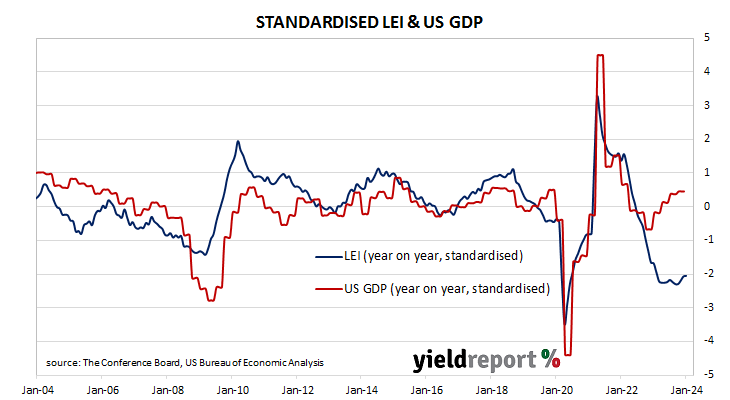Summary: Conference Board leading index down 0.4% in January, worse than expected; index currently does not signal recession ahead; US Treasury yields fall; rate-cut expectations firm; expects to near-zero real GDP growth in Q2, Q3; regression analysis implies 1.0% contraction in year to April.
The Conference Board Leading Economic Index (LEI) is a composite index composed of ten sub-indices which are thought to be sensitive to changes in the US economy. The Conference Board describes it as an index which attempts to signal growth peaks and troughs; turning points in the index have historically occurred prior to changes in aggregate economic activity. Readings from March and April of 2020 signalled “a deep US recession” while subsequent readings indicated the US economy would recover rapidly. More recent readings have implied US GDP growth rates would turn negative in the second half of 2023 or the first half of 2024.
The latest reading of the LEI indicates it decreased by 0.4% in January. The fall was slightly worse than the 0.3% decrease which had been generally expected as well as December’s revised figure of -0.2%.
“While the declining LEI continues to signal headwinds to economic activity, for the first time in the past two years, six out of its ten components were positive contributors over the past six-month period ending in January 2024,” said Justyna Zabinska-La Monica of The Conference Board.
US Treasury bond yields fell on the day. By the close of business, the 2-year Treasury yield had shed 4bps to 4.61%, the 10-year yield had lost 2bps to 4.27% while the 30-year yield finished 1bp lower at 4.44%.
In terms of US Fed policy, expectations of a lower federal funds rate in the next 12 months generally firmed, with several cuts factored in. At the close of business, contracts implied the effective federal funds rate would average 5.32% in March, slightly below the current spot rate, 5.31% in April and 5.235% in May. February 2025 contracts implied 4.26%, 107bps less than the current rate.
“As a result, the leading index currently does not signal recession ahead,” added Zabinska-La Monica. “While no longer forecasting a recession in 2024, we do expect real GDP growth to slow to near zero percent over Q2 and Q3.”
The Conference Board had previously forecast negative GDP growth in the June and September quarters of 2024. Regression analysis suggests the latest reading implies a -1.0% year-on-year growth rate in April, unchanged from the year to March growth rate after revisions to the previous month’s LEI.



